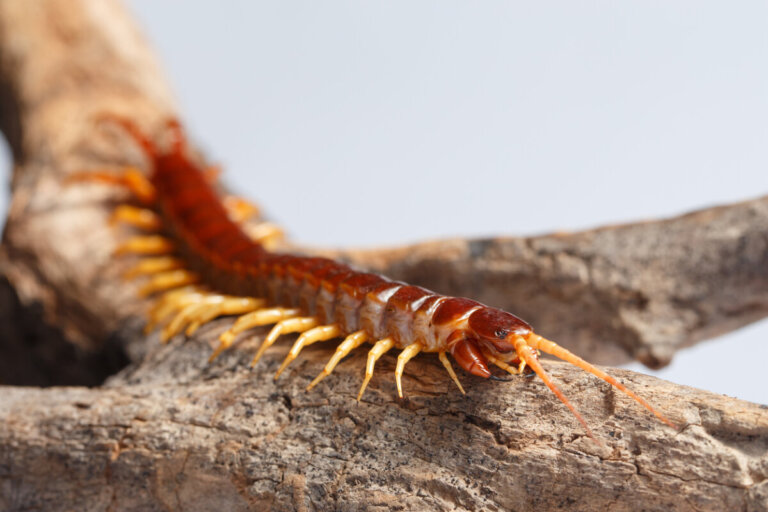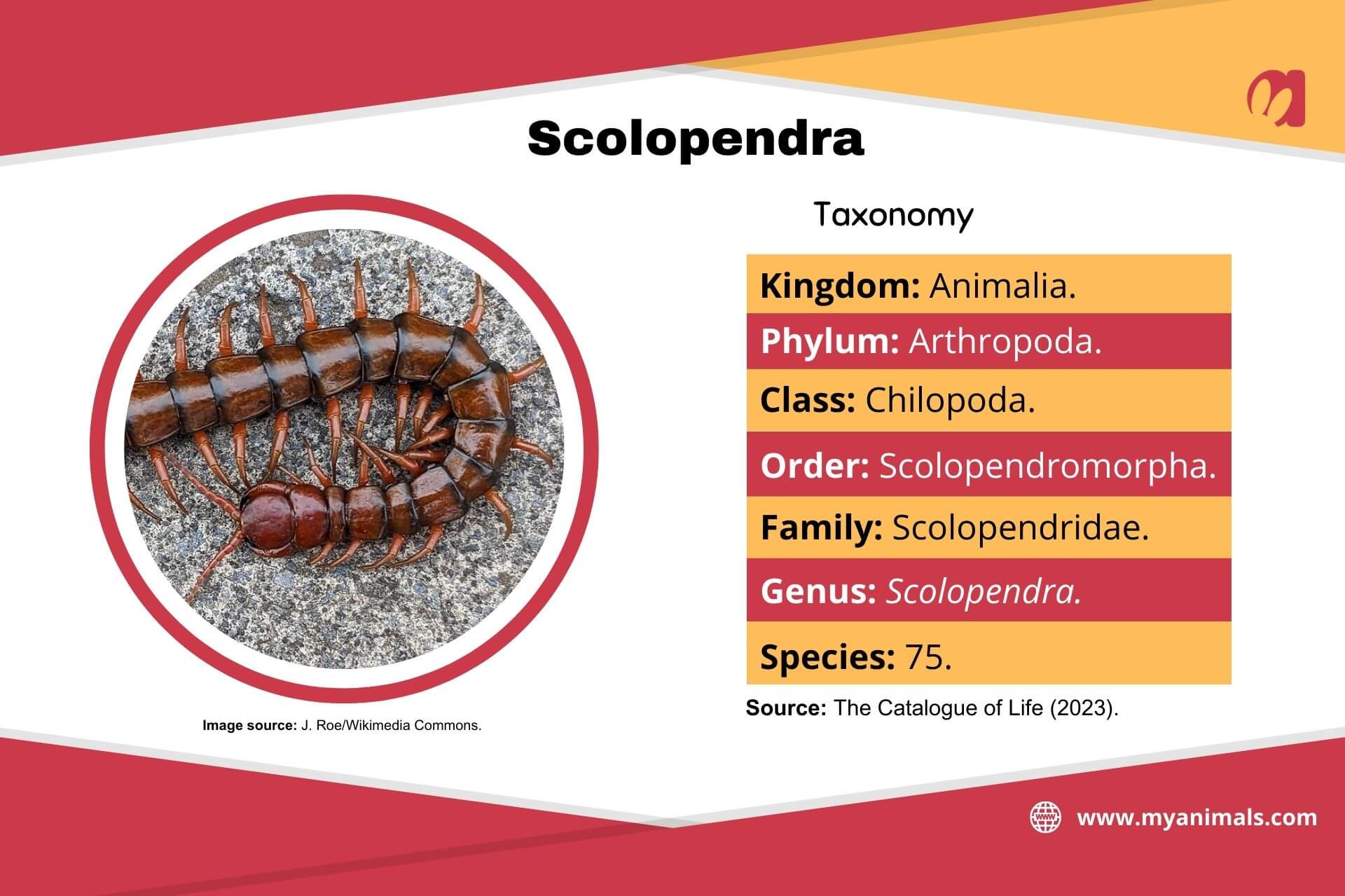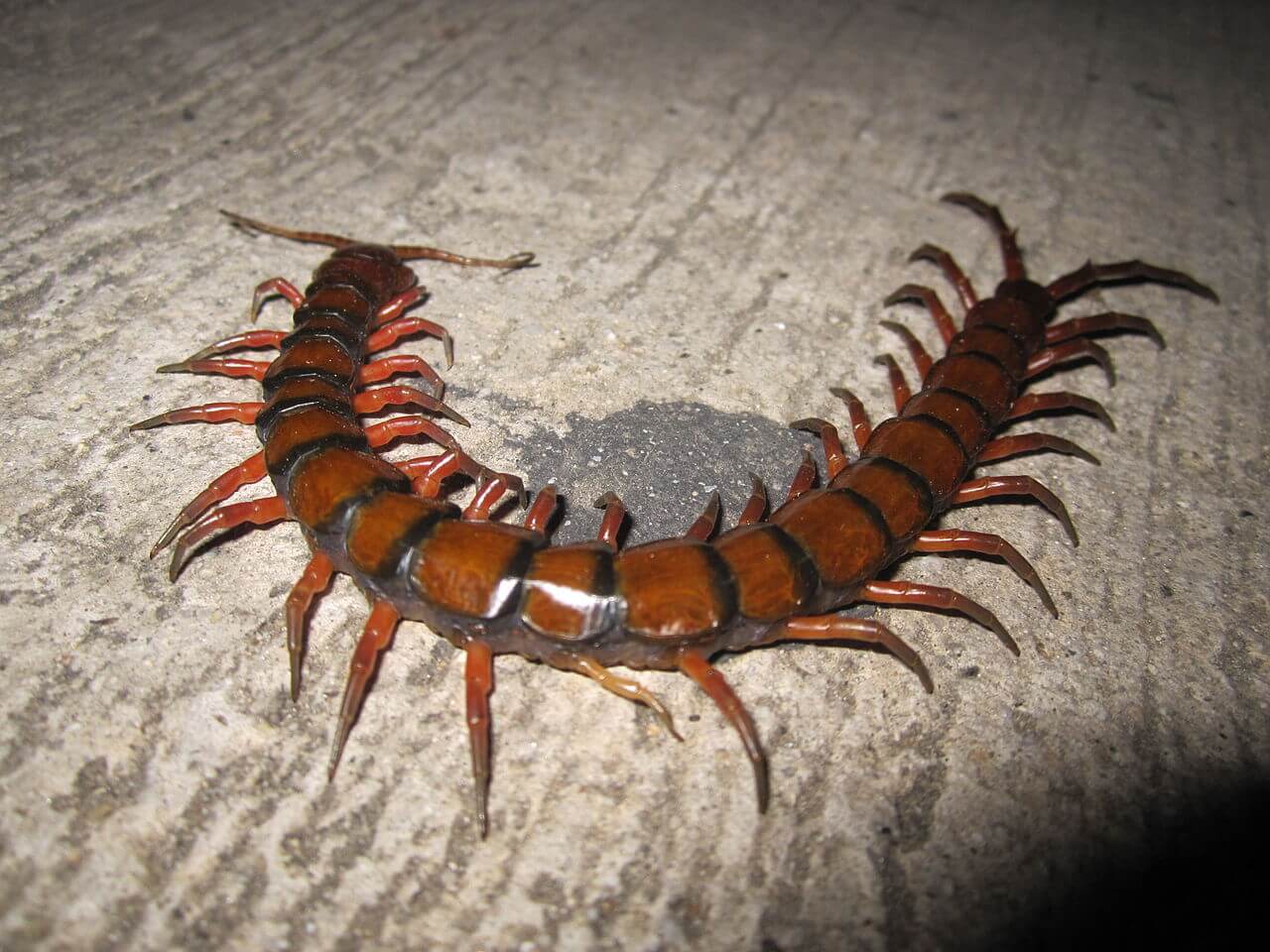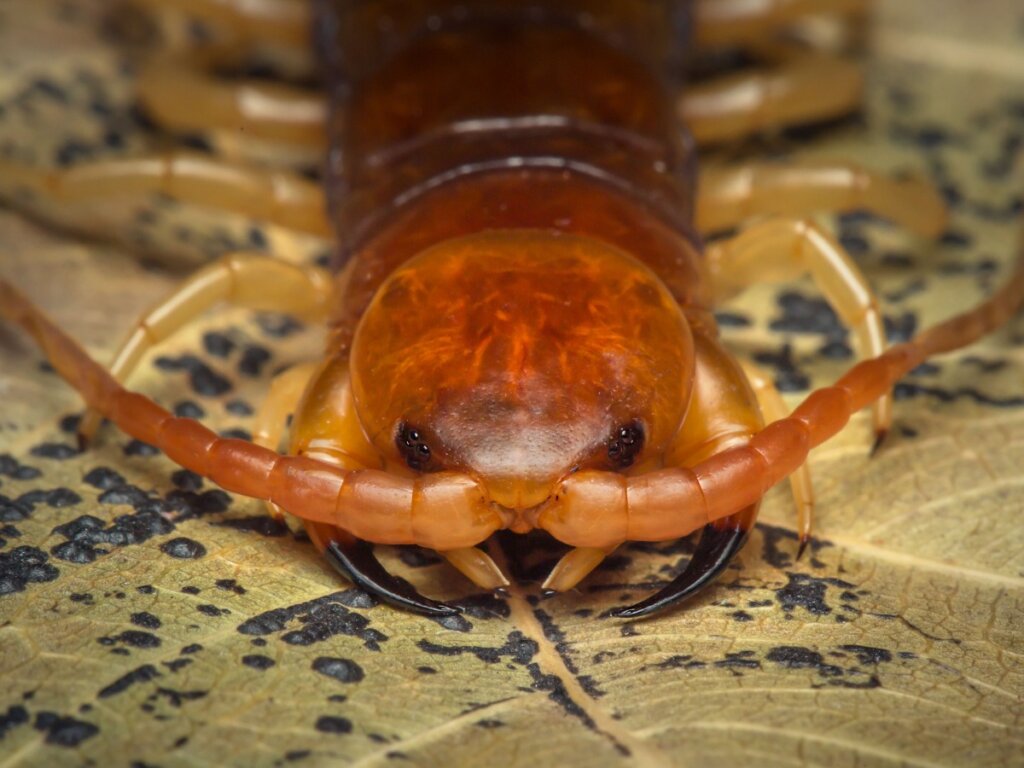The Genus Scolopendra: Characteristics, Habitat, and Bites


Reviewed and approved by the biologist Georgelin Espinoza Medina
Arthropods of the genus Scolopendra have a flattened body that usually has between 21 and 23 segments, each with a pair of legs. They’re carnivorous animals that release their venom to hunt their prey and protect themselves from possible threats. If a Scolopendra bites a person, it can trigger several disorders. In rare cases, it can cause death.
In the following article, you’ll learn about the physical features, habitat, diet, and reproduction of Scolopendrae, as well as all the details about their venom and the effects of their sting on humans.
Characteristics of the genus Scolopendra

About 80 different species have been discovered, among which we can find Scolopendra morsitans and Scolopendra gigantea as some of the most well-known, although there’s a possibility that there are many others that are still unidentified. They’re often referred to as centipedes and are classified in the taxonomic order Scolopendromorpha.
Members of the genus Scolopendra have an elongated anatomy that can reach 8 inches or more. On their head, large antennae and powerful mandibles stand out. Their thorax is segmented, allowing them to turn quickly and maintain their resistance.
This genus usually has a total of 21 segments, each with a pair of legs equipped with claws. Its morphology allows it to climb and cling firmly to any surface.
The legs closest to the jaws, known as forcipules, help it capture and apply the potent venom that paralyzes its prey.
With the exception of the forcipular legs and the pair of anal legs, all other legs are used for walking. The last two are dangling, but serve a vital function, both for defense against attacks in that area and for attracting the opposite sex during mating.

Habitat and diet
This arthropod can be found on all continents except Antarctica, as it prefers more temperate climates where its prey is abundant. A comparative investigation of the taxonomy of traditional morphology, published in the journal ZooKeys, found that the distribution range of the species is wide:
- Africa
- America
- Australia
- Tropical areas of Asia
- Some neighboring areas of the Indian Ocean
During the day, it takes refuge underground, hiding several inches below, as well as under fallen logs or stones.
Its body is hardy and can survive temperatures of up to 50 degrees Fahrenheit, but below this temperature, it will die. In cold climates, it tends to hibernate until the arrival of summer or spring.
Scolopendrae rarely go hunting in broad daylight. In fact, they prefer darkness to search for prey. Their diet includes a wide variety of insects, from very small ones to others of considerable size, as long as they have a chance of defeating them in battle.
In addition, they can feed on other Scolopendrae and also on small vertebrates, such as the following:
- Frogs
- Birds
- Mice
- Lizards
In more challenging situations, they use their potent venom to paralyze their prey. In this regard, they follow a tactic similar to that of constrictor snakes: They coil around their victim to prevent it from escaping and then dig into its jaws to inject the venom.

How do they reproduce?
These animals have separate sexes, without direct copulation, and fertilization is internal. Males deposit sperm sacs on the ground, known as spermatophores, which females must insert inside themselves.
The female Scolopendra lays between 20 and 60 eggs in her hidden burrows and guards them with great zeal. In fact, she even moistens them with saliva to prevent pathogens.
At birth, some of the offspring may devour their own mother.
The poison of the genus Scolopendra
The poison of the genus Scolopendra is one of the most potent toxins in existence, allowing it to deal with large insects.
According to a scientific review in the journal Salus concerning the toxic agents of the Scolopendra gigantea, a very complicated pattern of the following compounds is present in the venom of this species:
- Ketoses
- Proteins
- Carbohydrates
A paper published in The University of Queensland suggests that the Scolopendra morsitans can change the composition of its venom and use different combinations for defense or predation.
In addition, the secretion system is more complex than was thought a few years ago, as it doesn’t work exclusively by neuromuscular control. However, this would only be possible in species that have evolved with a long venom duct.
How dangerous is the Scalopendra bite to humans?
Scolopendrae have complex mouthparts that they use for feeding. They have two pairs of powerful jaws and two fused jaws, from which emerge forcipules, modified fangs with venom glands that allow them to capture and paralyze their prey.
Scolopendra venom is a combination of several toxins that affect different body systems. As such, it can disintegrate erythrocytes and cause symptoms such as cardiac arrest and fever.
The International Journal of Dermatology describes the manifestations of the venom after the bite in two clinical cases:
- Blisters
- Intense pain
- Severe erythematous edema
The bite may also cause the signs listed below:
- Pain
- Itching
- Swelling
- Redness
- A burning sensation
These symptoms can usually go away on their own without medical intervention. However, in severe cases, the following may occur:
- Necrosis
- Inflammation
- Pustule formation
Most bites cause benign local reactions, but in rare situations, the venom can cause other disorders, such as those reported by the journal Clinical Toxicology.
- Infarction
- Proteinuria
- Rhabdomyolysis
Although stings are rare in humans, caution should be exercised, especially with children, the elderly, or allergic persons, because, in severe situations, a reaction to the venom may lead to death.
In case of a severe sting with advanced bacterial infection, treatment may require surgical debridement and intravenous antibiotics. Therefore, it’s important to avoid approaching or handling these animals to prevent risks because contact with venom remnants can cause adverse reactions.
The genus Scolopendra: A long and venomous predator
The genus Scolopendra, with its venom-laden jaws and forceps, proves to be a formidable predator capable of taking on insects and small vertebrates.
Although their sting can trigger significant symptoms and, in severe cases, have serious consequences, they’re rare in humans. Caution should be exercised when exploring forests to avoid possible stings, as they’re fast and agile.
Caution should be exercised when interacting with these creatures, and handling them should be avoided to avoid unnecessary risks. With adequate knowledge about Scolopendrae and their behavior, it’s possible to appreciate their role in the ecosystem and enjoy their uniqueness from a safe distance.
Arthropods of the genus Scolopendra have a flattened body that usually has between 21 and 23 segments, each with a pair of legs. They’re carnivorous animals that release their venom to hunt their prey and protect themselves from possible threats. If a Scolopendra bites a person, it can trigger several disorders. In rare cases, it can cause death.
In the following article, you’ll learn about the physical features, habitat, diet, and reproduction of Scolopendrae, as well as all the details about their venom and the effects of their sting on humans.
Characteristics of the genus Scolopendra

About 80 different species have been discovered, among which we can find Scolopendra morsitans and Scolopendra gigantea as some of the most well-known, although there’s a possibility that there are many others that are still unidentified. They’re often referred to as centipedes and are classified in the taxonomic order Scolopendromorpha.
Members of the genus Scolopendra have an elongated anatomy that can reach 8 inches or more. On their head, large antennae and powerful mandibles stand out. Their thorax is segmented, allowing them to turn quickly and maintain their resistance.
This genus usually has a total of 21 segments, each with a pair of legs equipped with claws. Its morphology allows it to climb and cling firmly to any surface.
The legs closest to the jaws, known as forcipules, help it capture and apply the potent venom that paralyzes its prey.
With the exception of the forcipular legs and the pair of anal legs, all other legs are used for walking. The last two are dangling, but serve a vital function, both for defense against attacks in that area and for attracting the opposite sex during mating.

Habitat and diet
This arthropod can be found on all continents except Antarctica, as it prefers more temperate climates where its prey is abundant. A comparative investigation of the taxonomy of traditional morphology, published in the journal ZooKeys, found that the distribution range of the species is wide:
- Africa
- America
- Australia
- Tropical areas of Asia
- Some neighboring areas of the Indian Ocean
During the day, it takes refuge underground, hiding several inches below, as well as under fallen logs or stones.
Its body is hardy and can survive temperatures of up to 50 degrees Fahrenheit, but below this temperature, it will die. In cold climates, it tends to hibernate until the arrival of summer or spring.
Scolopendrae rarely go hunting in broad daylight. In fact, they prefer darkness to search for prey. Their diet includes a wide variety of insects, from very small ones to others of considerable size, as long as they have a chance of defeating them in battle.
In addition, they can feed on other Scolopendrae and also on small vertebrates, such as the following:
- Frogs
- Birds
- Mice
- Lizards
In more challenging situations, they use their potent venom to paralyze their prey. In this regard, they follow a tactic similar to that of constrictor snakes: They coil around their victim to prevent it from escaping and then dig into its jaws to inject the venom.

How do they reproduce?
These animals have separate sexes, without direct copulation, and fertilization is internal. Males deposit sperm sacs on the ground, known as spermatophores, which females must insert inside themselves.
The female Scolopendra lays between 20 and 60 eggs in her hidden burrows and guards them with great zeal. In fact, she even moistens them with saliva to prevent pathogens.
At birth, some of the offspring may devour their own mother.
The poison of the genus Scolopendra
The poison of the genus Scolopendra is one of the most potent toxins in existence, allowing it to deal with large insects.
According to a scientific review in the journal Salus concerning the toxic agents of the Scolopendra gigantea, a very complicated pattern of the following compounds is present in the venom of this species:
- Ketoses
- Proteins
- Carbohydrates
A paper published in The University of Queensland suggests that the Scolopendra morsitans can change the composition of its venom and use different combinations for defense or predation.
In addition, the secretion system is more complex than was thought a few years ago, as it doesn’t work exclusively by neuromuscular control. However, this would only be possible in species that have evolved with a long venom duct.
How dangerous is the Scalopendra bite to humans?
Scolopendrae have complex mouthparts that they use for feeding. They have two pairs of powerful jaws and two fused jaws, from which emerge forcipules, modified fangs with venom glands that allow them to capture and paralyze their prey.
Scolopendra venom is a combination of several toxins that affect different body systems. As such, it can disintegrate erythrocytes and cause symptoms such as cardiac arrest and fever.
The International Journal of Dermatology describes the manifestations of the venom after the bite in two clinical cases:
- Blisters
- Intense pain
- Severe erythematous edema
The bite may also cause the signs listed below:
- Pain
- Itching
- Swelling
- Redness
- A burning sensation
These symptoms can usually go away on their own without medical intervention. However, in severe cases, the following may occur:
- Necrosis
- Inflammation
- Pustule formation
Most bites cause benign local reactions, but in rare situations, the venom can cause other disorders, such as those reported by the journal Clinical Toxicology.
- Infarction
- Proteinuria
- Rhabdomyolysis
Although stings are rare in humans, caution should be exercised, especially with children, the elderly, or allergic persons, because, in severe situations, a reaction to the venom may lead to death.
In case of a severe sting with advanced bacterial infection, treatment may require surgical debridement and intravenous antibiotics. Therefore, it’s important to avoid approaching or handling these animals to prevent risks because contact with venom remnants can cause adverse reactions.
The genus Scolopendra: A long and venomous predator
The genus Scolopendra, with its venom-laden jaws and forceps, proves to be a formidable predator capable of taking on insects and small vertebrates.
Although their sting can trigger significant symptoms and, in severe cases, have serious consequences, they’re rare in humans. Caution should be exercised when exploring forests to avoid possible stings, as they’re fast and agile.
Caution should be exercised when interacting with these creatures, and handling them should be avoided to avoid unnecessary risks. With adequate knowledge about Scolopendrae and their behavior, it’s possible to appreciate their role in the ecosystem and enjoy their uniqueness from a safe distance.
All cited sources were thoroughly reviewed by our team to ensure their quality, reliability, currency, and validity. The bibliography of this article was considered reliable and of academic or scientific accuracy.
- Fisher, A. (2021). Así es el ciempiés gigante que caza aves en Australia. National Geographic. Consultado el 28 de julio de 2023. https://www.ngenespanol.com/animales/asi-es-el-ciempies-gigante-que-caza-aves-en-australia/
- Fuentes, E., Granado, C., Moreno, C., Fernández, R., Hernández, J., & Palacios, M. (2022). Perfil proteico y de carbohidratos del veneno de la Scolopendra gigantea. Salus, 26(2), 9-17. http://servicio.bc.uc.edu.ve/fcs/vol26n2/art02.pdf
- Ribera, I., Melic, A., & Torralba, A. (2015). Introducción y guía visual de los artrópodos. Revista IDE@ – SEA, 2, 1-30. https://www.researchgate.net/profile/Antonio-Torralba-Burrial/publication/280681226_Introduccion_y_guia_visual_de_los_artropodos/links/55c0f86908ae092e96683b7f/Introduccion-y-guia-visual-de-los-artropodos.pdf
- Schendel, V. (2022). Centipede venom: Modulation, functional neuro-anatomy and evolutionary origin of the venom gland. [PhD Thesis] The University of Queensland. https://espace.library.uq.edu.au/view/UQ:6e6cad6
- Siriwut, W., Edgecombe, G. D., Sutcharit, C., Tongkerd, P., & Panha, S. (2016). A taxonomic review of the centipede genus Scolopendra Linnaeus, 1758 (Scolopendromorpha, Scolopendridae) in mainland Southeast Asia, with description of a new species from Laos. ZooKeys, (590), 1. https://www.ncbi.nlm.nih.gov/pmc/articles/PMC4926625/
- Veraldi, S., Çuka, E., & Gaiani, F. (2014). Scolopendra bites: a report of two cases and review of the literature. International Journal of Dermatology, 53(7), 869-872. https://onlinelibrary.wiley.com/doi/abs/10.1111/ijd.12434
- Yao, X., Dong, Q., Chen, Y., Feng, Z., & Li, Y. (2013). Acute disseminated encephalomyelitis following biting by a scolopendra subspinipes mutilans. Clinical Toxicology, 51(6), 519-520. https://www.tandfonline.com/doi/full/10.3109/15563650.2013.804929
This text is provided for informational purposes only and does not replace consultation with a professional. If in doubt, consult your specialist.








